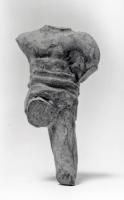Kalinowski, Angela
Pages
-

-
Gladiator
-
Bronze figure of a gladiator wearing armour. Modern pedestal., Dating to c. 1st-2nd century CE, this figure was most likely mounted on a wagon or furniture., British Museum. “wagon-fitting/furniture-fitting/figure.” The British Museum Collections Online. Accessed May 19, 2017. http://www.britishmuseum.org/research/collection_online/collection_object_details.aspx?objectId=399748&partId=1&searchText=gladi
-

-
Gladiator
-
Terracotta figure of a gladiator. The head, arms, and most of both legs are missing., Dates to c. 1st-2nd century CE., British Museum. “figure.” The British Museum Collections Online. Accessed May 19, 2017. http://www.britishmuseum.org/research/collection_online/collection_object_details.aspx?objectId=1420846&partId=1&searchText=glad
-

-
Gladiator
-
Bronze figure of a Retiarius gladiator in armour holding a trident., Dates to c. 1st-2nd century CE., British Museum. “figure.” The British Museum Collections Online. Accessed May 19, 2017. http://www.britishmuseum.org/research/collection_online/collection_object_details.aspx?objectId=399754&partId=1&searchText=gladi
-

-
Gladiator Lamp
-
Lamp in the shape of a murmillo. The gladiator is standing holding a shield in his left hand and a gladius in his right with a manica on his right arm and greave on his left leg. He wears a helmet with circular holes that is characteristic of a murmillo. The wick hole is in the front of the shield; a loop on the top of his head forms the handle., Dates to c. 1st-2nd century CE.
-

-
Gladiatrix Relief
-
A marble relief depicting two female gladiators, named Amazon and Achillia, in the inscriptions below. They are both armed with swords and shields attacking each other. Their helmets appear at the near the bottom of the relief on either side of the platform on which they stand., Dates to c. 1st-2nd century CE. Marble relief commemorates either the discharge or release of the two female gladiators after a draw., British Museum. “relief.” The British Museum Collections Online. Accessed November 22, 2017. http://www.britishmuseum.org/research/collection_online/collection_object_details.aspx?objectId=399637&partId=1&searchText=femal
-

-
Halter
-
Stone weights held by athletes competing in long or broad jump., Unknown date. See in this collection Bell Krater with Jumpers.
-

-
Handle with Athlete
-
Bronze handle depicting a partially nude female athlete wearing shorts and shoes with her hands extended above her head, supporting the upper part of the handle., Dates to c. last quarter of the 6th century BCE. Originally it was a part of a patera. Having the handle in the shsape of a human was popular in Greek art from the late 6th century through the mid-5th century BCE., Metropolitan Museum of Art. "Bronze patera handle in the form of a young woman." The Metropolitan Museum of Art Online. Accessed May 19, 2017. http://www.metmuseum.org/art/collection/search/254546
-

-
Head of Athlete
-
Head of a male figure wearing a fillet. Damage to the face., Also identified as Apollo or Lachos. Roman copy dating to c. 120-180 CE of a Greek original dating from c. 470-460 BCE., British Museum. “Figure.” The British Museum Collections Online. Accessed May 19, 2017. http://www.britishmuseum.org/research/collection_online/collection_object_details.aspx?objectId=406432&partId=1&searchText=greek
Pages
